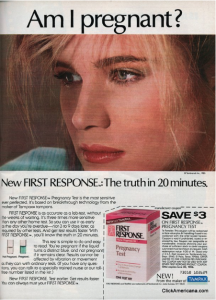In the dim recesses of my memory is a breakfast meeting overlooking the Charles River at the Howard Johnson’s Hotel on Memorial Drive attended by Tom Benjamin, David Livingston, Irving Berstein and me. Irving was a serial entrepreneur, who I’d met through a Wash. U. friend who was working as an assistant to him, during his day job, running the Health Sciences and Technology Program at MIT.
I had just finished my PhD, was freshly back from a job interview at Genentech, and was planning a post-doc at Harvard. But, my funding had been cut because of Ronald Reagan’s Presidency and Federal Budget Freeze. It was Reagan’s first budget during the Winter of 1981-1982 and biotech (which was hardly a word, then), was feeling the first effects of Presidential disdain for Research.
Irving had this idea: There could be a better pregnancy test than the one already on the market. This one with antibodies coupled to a color change, that would make it easy to tell when the test was positive. Tom Benjamin and David Livingston were there to assure
Irving that it was possible. I was there to (hopefully) assist in the writing of a business plan. I was out of a job, had successful grant writing experience, knew the field, and could no doubt make a contribution.

Except, I needed to make a living.
One thing I did not then understand about entrepreneurs was how penurious they were.
The content of the meeting was more about meeting business plan objectives within a given time frame and the size of the effort required. To my knowledge, formal design controls weren’t invented until 15 years later, so we had no understanding of those. But, there was a technique, pioneered at Harvard Business School, within sight of our breakfast meeting, for writing detailed plans for a business, complete with projected cash flows, and I’d read the popularized versions for doing this, mainly authored by Joe Mancuso, a Worcester Polytech. graduate who’d written widely sold books on the subject. I hadn’t yet met Joe.
After the meeting, I went back to my one bedroom apartment near Davis Square in Somerville; an apartment jammed with boxes sent by my then girlfriend who lived in Austin, who was about to make the trek to Boston, to live with me. Therein was the greatest cause for my non-acceptance of the Genentech post-doc. One of my close friends was at Genentech in South San Francisco, but I hadn’t seen him during the job interview (he was a protein person; I was nearly all nucleic acids all the time). And, I knew that I might be making a mistake by not going west; but the time wasn’t right for me personally. And, so I intended to do as best I could for myself at Harvard.
Irving called. I had started on the business plan but he wanted to discuss salary. Starting for a post-doc in those days, after years of training was $ 13,300. He wanted to pay me $ 12,000. I was flabbergast. It was difficult enough to have gone from a $9600 a year salary as a technician in St. Louis to a $ 3000 stipend for the past four years at Tufts; but now, to be cut down to only a bit more than I’d made as a technician five years earlier was too much. I argued for more, but Irving wouldn’t budge. Ultimately, he said that he would give me $12,000 for 1982 and $14,000 for 1983, and wouldn’t that be the same? I couldn’t believe my ears. I turned him down.
Eventually, Bill Haseltine offered me a post-doctoral position at the Sidney Farber Cancer Institute and within a few months, I was working just downstairs from David Livingston.
But, every once in a while, I checked in with Irving, after he’d moved to a lab and office in Waltham, to keep his new venture going. He told me the research was more difficult than he’d anticipated and that it was taking longer.
I even visited once, when I was looking for a new position in late 1984. By then, he had re-formatted the test and was ready to submit it to the FDA as substantially similar to the tests already on the market, using the mantra that it could determine pregnancy “six days earlier” and its competitors.
In the end, Irving had ended up with a “me too” product. Not a great innovation, but a reasonably well thought-out new home test. Large chains picked it up, commercials were made, and Irving had made another great hit, before his next incarnation at Texet. Yes, I introduced him to that company where he was CEO for several years. But I’ll leave that story for another day.
